Complex regional pain syndrome (CRPS) is a chronic pain condition that typically affects a limb, like a leg or an arm. Damage or malfunction to the central nervous system is what is believed to cause complex regional pain syndrome. The central nervous system contains the brain and spinal cord. Things like injuries, surgeries, strokes, or heart attacks are common causes.
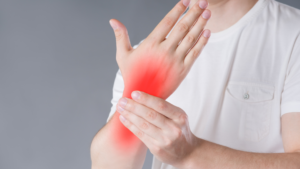
What is Complex Regional Pain Syndrome
This condition is not common. In fact, it is difficult to diagnose and is historically tricky to treat. The affected area is not only extremely painful but other symptoms can include a change of body temperature, discoloration, and swelling in the affected area.
CPRS can be divided into two types: CRPS-I and CRPS-II. CRPS-I is previously known as reflex sympathetic dystrophy (RSD) syndrome. This type is when patients do not have a confirmed nerve injury or disorder. CRPS-II (also known as causalgia) is when the condition stems from a confirmed nerve injury. Despite there being two types of CRPS, treatments are similar.
Symptoms of Complex Regional Pain Syndrome
The symptoms of CRPS vary. The main symptom that is present is long-term severe pain that may be constant. This pain is often described as burning or a pins-and-needles sensation. Symptoms may change over time, but pain, swelling, redness, and hypersensitivity (allodynia) are typically the first symptoms that occur. Pain has been known to spread, even if the affected area is only a hand or even finger. While this is rare, complex regional pain syndrome may spread to other extremities, such as the opposite limb or other area of the body.
Symptoms can go away on their own, overtime.
Other symptoms of CRPS include:
- Changes in hair growth patterns
- Joint stiffness
- Decreased muscle coordination
- Abnormal sweating pattern in the affected area
- Tremors or jerking of the affected limb
Diagnosis and Treatment Options
Diagnosis
CRPS is diagnosed based on a patient’s medical history and present symptoms. It is especially difficult to diagnose because the symptoms are common to other conditions as well. As a person’s symptoms improve, it is even more difficult to diagnose.
Certain tests are used to rule out other disorders and conditions that display similar symptoms, such as arthritis, Lyme disease, a clotted vein, or a general muscle disease. These tests can provide your physician with clues about what is causing your pain. A careful examination should be performed to determine if an injury is the root cause of the pain – the key feature to CRPS. Thorough examinations help assess the pain and determine if other treatable conditions are present and not ignored.
Imaging tests such as magnetic resonance imaging or triple-phase bone scans may be used to confirm a diagnosis. CRPS is often related to a process where certain cells break down bone and release calcium into the blood. However, this symptom can be caused by other diseases as well. X-Rays are used to show a loss of minerals from your bones. This is common in later phases of the disease. Sympathetic nervous systems tests look for disturbances in your sympathetic nervous system by using thermography to measure your skin temperature and blood flow. Other tests can measure the amount of sweat on your limbs. Irregular results can lead to an accurate prognosis of complex regional pain syndrome.
Treatment Options
The goal of treatments is to lower the intensity of pain and reduce muscle spasms. Your physician may recommend different types of treatment options depending on the severity of your pain and symptoms you experience.
Therapies include:
- Physical Therapy: Physical therapy is used to keep the painful body part moving to increase blood flow. Exercise helps increase flexibility, builds strength, and improves the function of the affected area.
- Nerve Blocks: Sympathetic nerve blocks can provide temporary relief from pain, but does not have any long-term benefits. Nerve blocks involve injecting an anesthetic next to the spine to block the nerves from communicating pain signals with the brain.
- Medications: Various medications are used to help reduce pain. Your doctor may recommend over-the-counter pain relievers such as Naproxen, Ibuprofen, or Aspirin. If a patient is suffering from neuropathic pain, antidepressants may be prescribed. Corticosteroids, such as prednisone, are used to reduce inflammation and improve mobility.
- Heat Therapy: Applying heat may reduce swelling and discomfort on skin that has varying temperatures.
- Biofeedback: Biofeedback techniques help you become more aware of your body so you can train it to relax and reduce pain. This involved being hooked up to an electrical sensors that measure your bodily functions like heart rate. This information helps train your mind and body to understand your pain on a deeper level.
Contact Progressive Pain Management to learn more about complex regional pain syndrome treatment options. Fill out the form below to get started.
Anyone with stiff joints or chronic pain knows how relaxing it can be to slip into a warm bath at the end of the day. This is because the water pressure alleviates the pressure you place on your joints. There is a lot of science behind this buoyant force, and it is the same reason why you feel weightless in water.
When you live with chronic pain, you know that any relief is welcomed. Many pain specialists and physical therapists recommend water therapy for patients with fibromyalgia, osteoarthritis, or chronic joint pain. This does not always mean participating in group water aerobics. Aquatic therapy can also include floating therapy and water yoga.

Aquatic Therapy to Help Reduce Pain
How Aquatic Therapy Helps Ease Chronic Pain
- Water Aerobics for Osteoarthritis
People with osteoporosis benefit greatly from doing water exercises. This allows their muscles to stretch and strengthen using the gentle resistance of water. Stretches like lifting your knees to your chest and using the side of the pool to do leg lifts and arm stretches are good for your muscles and improve your range of motion.
Water aerobics are another type of therapy that prove beneficial for patients with osteoarthritis. Walking in the water, water jogging, and other movements that make your hip joints more limber build strength without having to exercise on a treadmill.
- Floating Therapy
The most simple type of aquatic therapy is floating therapy. This is to simply float. This can be done floating vertically, so that your body is deeply emerged in water. This lets the water pressure have a more therapeutic benefit – the deeper you go, the stronger the pressure. Floating can lower your blood pressure and improve neurological conditions.
Another type of floating that has profound neurological benefits and can aid in relaxation therapy is floating in a super Epsom salt bath. This is a shallow, high-buoyancy tub that focuses on sensory deprivation. Sensory deprivation is a relaxation technique that helps eliminate external stimuli that affects pain.
- Hot Tub Therapy
Patients with back pain regularly find relief from their pain when heat is applied. A take on heat therapy, hot tub therapy combines relaxation from aquatic therapy and the warmth of heat therapy. This also helps patients with osteoarthritis and fibromyalgia. The warm, bubbly water lessens joint stiffness and pain. It also boosts blood flow to the affected area.
Be sure to follow your physician’s recommendations regarding hot tub therapy. The heat can occasionally cause headaches or dizziness, so always follow healthy hot tub regulations.
- Water Yoga
Just like on dry ground, doing water yoga is a well-known rehabilitation technique for patients with chronic pain. However, water yoga adds in a natural resistance. Water pressure encourages deeper, diaphragmatic breathing which is important to the practice of yoga. Yoga is good at preventing muscle soreness, reducing low back pain, and improving neurological conditions. Many yoga stretches are more comfortable when you have the water pressure working against you instead of gravity. It can be easier to sustain the poses and make the poses more effective.
Living with chronic pain is uncomfortable and can prevent you from doing what you love. Easing the symptoms with aquatic therapy can help, but getting the right kind of help from a qualified physician is best. Contact the team at Progressive Pain Management today using the form below.
After surgery, pain is natural. Managing and controlling that pain is crucial to your healing and recovery. More than 80% of patients report pain after surgery. While you should expect some pain after surgery, your physician will take proper precautions and every effort to lessen your pain.
Managing pain after surgery is the most effective way to ensure a healthy recovery. Having a postoperative treatment plan may help reduce the risk of developing complications. When your pain is properly managed, your quality of life will be restored, and essential tasks like walking can be resumed normally.
Post-Surgical Pain Care
Pain after surgery may surprise you. Oftentimes, the painful area is not where the surgery was performed, but instead, referred pain. This means the pain is experienced somewhere other than the affected area. Referred pain occurs because of how pain signals travel along you nerves.

The Importance of Post-Surgical Pain Care
Other types of pain you may experience after surgery are:
- Muscle Pain: Lying in a chair or operating table can result in pain in your neck, shoulders, back, or chest.
- Throat Pain: After surgery, you may experience scratchiness or dryness in your throat. This can make it sore and uncomfortable.
- Movement Pain: Moving and performing important tasks like sitting, walking, and even basic movements like arms and feet can cause pain at or around the incision site or affected area.
Treatment Options for Pain Relief
The goal of pain management after surgery is to relieve an uncomfortable, painful experience and to control pain. However, when there is postoperative pain, you might think the surgery was a failure. Pain after major surgery is to be expected. Your doctor will work with you to determine the best course of action and an effective treatment plan.
Nerve Blocks
Your doctor may recommend a nerve block to control your pain after surgery. Nerve blocks are minimally invasive injections that block pain signals from reaching your brain. This type of treatment helps cut down on the amount of pain medication you will need to take.
Over-the-Counter Pain Medication
Your doctor will likely order over-the-counter pain medications to help relieve your pain after surgery. These medications often include anti-inflammatory medications such as Advil and pain relievers like Tylenol. Over-the-counter medications have minor side effects, if any at all, and are safe to take without the risk of forming an addictive habit. Be sure to follow your doctor’s instructions
At-Home Techniques
There are a number of at-home techniques designed to help relieve pain during recovery.
- Relaxation Techniques: Listening to calming music, biofeedback, and meditation a few of the ways you can relieve your pain at home. Learning to focus your attention on something other than your pain is a natural way to lessen your pain.
- Heat & Cold Therapy: This is an option to reduce swelling and control your pain at home. Your doctor will advise you on how to do this at home. Sometimes only heat, only cold, or an alternating method of both can be effective.
- Exercise: As your healing permits, slowly incorporating low-impact cardio and strength-training exercises help your body reduce pain. Exercise releases endorphins which act as your body’s natural opiate, therefore lessening your pain and discomfort. Exercise should only be done once your doctor has cleared you to resume normal activity. Always consult your physician before beginning an exercise routine.
Regardless of how your postoperative pain is managed, make sure you are comfortable with the treatment plan. Keep open lines of communication with your doctor and nurses to address any concerns or issues that may arise. Stress, anxiety, and miscommunication can all make your pain worse and cause a negative healing experience.
Fill out the form below to contact the team at Progressive Pain Management and learn about treatment options for continual care and pain management.
The field of pain management typically deals with traditional methods for evaluating, diagnosing, and treating various types of acute and chronic pain. However, as more research develops and the field of medicine progresses, physicians are able to learn about the complex intricacies of pain. This has led to a sub-specialty called interventional pain management.
What is Interventional Pain Management?
Conventional pain management treatments such as prescription medications, physical therapy, and other non-invasive techniques help reduce pain. What interventional pain management does differently is that it uses injections and radiofrequency to directly address and treat the root cause of your pain.

What is Interventional Pain Management?
Understanding a patient’s pain, the physiology of pain, and available treatments allows pain management specialists to create a multidisciplinary approach that utilizes a variety of techniques best suited to your pain and lifestyle. Interventional pain management has broadened the scope of technology and treatments that are available, effective, and ultimately able to restore your quality of life.
Types of Interventional Pain Management
Injections like nerve blocks, epidural steroid injections, facet joint injections, neuromodulation, and other interventional techniques are used to treat chronic pain disorders with great accuracy and precision.
Physicians oftentimes will use fluoroscopy to perform the injection. This type of X-Ray guidance allows your physician to see exactly where the injection is being placed in the joint to address the source of pain.
Nerve Block
A nerve block is an injection that is directed towards a specific nerve or group of nerve to treat pain. The injection, an anesthetic or anti-inflammatory medication, blocks the pain signal traveling from that location to your brain, quite literally “turning off” the pain you feel. The block decreases inflammation in the affected area.
Epidural Steroid Injection
Epidural steroid injections are another type of nerve block, but they are injected into the epidural space of the spine. The medication calms the nerve, reducing the painful sensations you feel. Epidural steroid injections are used to treat patients with pain caused by a compressed spinal nerve root, sciatica, and even osteoarthritis.
Facet Joint Injections
Facet joints connect the bones of the spine together, allowing for motion and movement. Inflammation causes pain, and facet joint injections can be used to reduce that pain. These injections are placed alongside the joint, and usually involve a concoction of both a steroid and numbing agent. Patients who have not had success with conventional treatments and suffer from neck, arm, low back, or leg pain that is caused by inflammation of the facet joints is a candidate for this procedure.
Radiofrequency Lesioning
Radiofrequency lesioning reduces pain by preventing transmission of pain signals. Radiofrequency utilizes electrical currents to essentially burn small piece of nerve tissue, creating a long-lasting interruption of pain signals to the brain. This is a non-surgical option to reduce chronic pain
Spinal Cord Stimulation
Spinal cord stimulation (SCS) is a type of neuromodulation that helps treat pain that affects the central, peripheral, or autonomic nervous systems by providing electrical stimulation via implanted devices. A small device, similar to that of a pacemaker, is implanted in the back along the spine. The generator transmits low-voltage electrical currents to the spinal cord instead of pain signals. Patients may feel a slight tingling sensation instead of their pain.
Living with chronic pain is not normal, and patients should know that technology is quickly evolving to provide physicians with the most effective and state-of-the-art treatment options for battling chronic pain. Fill out the form below to learn more about how chronic pain can be managed with an interventional pain specialist. The team at Progressive Pain Management is here to help you reduce pain and improve your quality of life.
Osteoarthritis is a gradual disease, with symptoms that appear over a long period of time. Depending on the joints and bones that are affected, symptoms vary, some that are more severe than others.
Osteoarthritis affects over 27 million Americans each year. The symptoms mirror those of other chronic illnesses as well as show up differently depending on the patient’s lifestyle, making it hard to diagnose. However, there are early signs of osteoarthritis to watch for that can help make an accurate diagnosis.
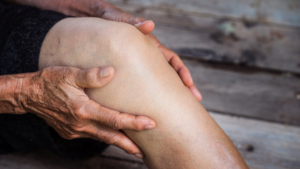
Osteroarthritis Warning Signs
Early Warning Signs of Osteoarthritis
- Joint Pain: Pain that worsens with activity and finds relief after a period of rest is suggestive of osteoarthritis. This is often one of the first signs of an issue with a joint. The discomfort of early osteoarthritis can be classified in two different ways: tenderness and pain. Patients don’t always suffer from debilitating pain, but experience aches or tenderness around the joints.
- Swelling: There is naturally occurring fluid in your joints. There is pain when the fluid builds up and causes the joint to swell. The extra fluid is created by the soft tissue that surrounds the joints.
- Loss of Flexibility: Early stages of osteoarthritis can cause body parts to not move as easily as before. Pain and stiffness contributes to this loss in flexibility and range of motion. Fully bending and extending a joint may become difficult or impossible. This has the ability to make daily activities hard to do. A loss in flexibility or range of motion is a very gradual process.
- Abnormal Sensations: The cartilage between your bones is meant to act as a “shock absorber” and to keep your joint moving smoothly. When this cartilage becomes worn out or torn, the bone-on-bone rubbing can cause abnormal sensations such as crackling, grating, or clicking can occur. Sometimes these sensations are felt, heard, or both. The bones rubbing together (grating) is common for patients with osteoarthritis.
- Joint Stiffness: Similar to joint pain, joint stiffness is commonly an early sign of osteoarthritis. Stiffness is common after sitting or laying for long periods of time. That sluggish, slow-to-move start in the morning could be an early sign of osteoarthritis. Oftentimes, joint stiffness fades as you move around and the joints have gotten a chance to loosen up.
If you experience these symptoms regularly, talk to your doctor. Test and examinations can be performed to accurately diagnose what is causing your pain. The earlier the detection, the more effective treatments will be. Osteoarthritis does not have a cure, but is manageable and there are treatments designed to help reduce pain and to help patients who suffer with pain get back to doing the things they love.
People who live with chronic joint pain know how debilitating it can be. Joint pain makes doing daily activities difficult and typically has a negative effect on the quality of life. It can steal away joy from doing the things they love and spending time with loved ones.
Chronic joint pain affects approximately 100 million Americans each year. Fortunately, there are exercises and self-care practices that help reduce and maintain pain. Exercises are designed to reduce inflammation, increase mobility, strengthen joints, and regain range of motion. Ideally, by implementing an exercise routine, there is no need for medication to manage the pain.
Working with a physical therapist or pain specialist is a great way to learn the proper exercise techniques that will help manage and reduce chronic pain. It’s important to remember not to force exercise or continue if it worsens your pain. Listen to you body and do what feels best!
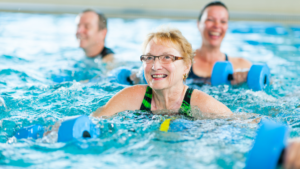
Exercises to Help Reduce Chronic Joint Pain
Always consult your doctor before starting any exercise program.
Types of Exercises to Reduce Chronic Joint Pain
Stretching
Stretching helps relieve tension and stiffness that causes joint pain. Stretching does not require any equipment, so these can be done at-home, on-the-go, or even at work. Stretches are designed for certain areas of pain, like knee pain, neck pain, and back pain.
Cardio
Cardiovascular exercises have a large impact on chronic pain and reducing symptoms that are caused by living with pain. Little-to-no equipment is needed for cardio exercises and they are relatively easy to incorporate into your daily life. Walking is the easiest way to get moving and increase your heart rate, endurance, and strength. If walking is challenging at first, start with short walks and slowly build up the distance overtime.
Swimming and water aerobics are another great cardio option for those living with chronic pain. Being in the water takes the pressure off your joints so you can exercise with ease. This is especially important for patients with low-mobility. Moving in the water adds natural resistance while no additional stress or pressure on your joints is present. Being in the water is often therapeutic, too. Improving your mood is critical to managing chronic pain.
Low-Impact Group Classes
Low-impact exercises are a great way to build muscle strength to better support joints that cause pain. Group setting classes, such as cycling or aerobics, can be beneficial to pain patients. Group classes are usually designed around a certain level of ability, meaning pain patients can take classes that best suit their needs and functions. Group settings are also great for accountability, which is important when trying to exercise regularly.
Cycling, for example, is a smoother motion for the joints than jogging, which can cause further damage and pain. If your pain levels allow, trying cycling a few times a week. The pedaling motions and breathing rhythms are excellent for increasing oxygen flow to the muscles and releasing endorphins that reduce chronic pain.
Balance Exercises
Exercises that focus on balance, core strength, and self-awareness like Yoga, Tai Chi, and Pilates are excellent for managing pain. They improve coordination and balance, which helps increase a sense of where joints are located and how to relieve tensions and pressure on those joints. These exercises include moves that increase flexibility and range of motion. This can loosen joints, which improves their function.
These exercises will help teach proper posture and body positions that align your joints and muscles, in hopes that your pain will be reduced. At Progressive Pain Management, our team can help create a plan incorporating exercise with interventional pain management techniques.
Fill out the form below to learn more.
The Dorsal Root Ganglion (DRG) is a small bundle of nerves connected to each vertebra along your spine. The DRG is critical in processing pain signals and transmitting them to your brain. They have a particularly important role in how you experience pain. The DRG act as the body’s internal traffic light: they control when signals can enter the spinal cord, therefore allowing pain signals to travel to the brain.
The Dorsal Root Ganglion neurons modify your sensory perception (how you feel pain) before transmitting the signal to your spinal cord and central nervous system. This makes DRG stimulation an effective treatment approach for patients with chronic pain.
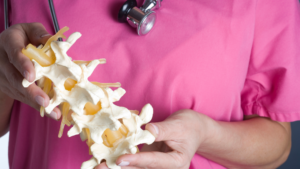
What is Dorsal Root Ganglion Stimulation?
Dorsal Root Ganglion stimulation utilizes a pulse generator that is implanted on the spine. The implant uses small electrical leads which are threaded into the epidural space where the DRG lies. The leads send a small electrical impulse to the area where the DRG is located. The impulses stimulate the Dorsal Root Ganglion to create a “red light.” This blocks pain signals from that specific area traveling to the brain.
The impulses either create a slight tingling sensation in the affected area, or has the ability to stop the pain altogether.
Benefits of DRG Stimulation
There are four specific benefits of targeting the Dorsal Root Ganglion for pain relief:
- Directed Targeting: Because the stimulator is implanted exactly where the pain is rooted, DRG stimulation can relieve pain in a specific area. The accuracy of this treatment has proven effective in 94.5% of patients who received targeted areas of pain.
- Low Energy: DRG stimulators use a tiny amount of energy – only about 10% of the energy that is required from a conventional spinal cord stimulator. The batteries in the DRG stimulator last longer because of the low energy requirement.
- Low Risk of Lead Migration: The DRG stimulators are tucked into a small space, limiting the chances of lead migration. There is reported less than 1% migration rate, whereas a traditional SCS reports an approximate 14% migration rate.
- Minimal Effects on Body Position: Due to the DRG’s location in the epidural space, the cerebrospinal fluid in between electrodes does not affect the patient’s posture or body position. The stimulation patterns remain constant regardless of any changes in the body’s position. Whether lying down, sitting down, standing, or walking, the patient receives the same pattern.
Your physician will first implant a trial DRG Stimulator using fluoroscopic guidance. Data is collected from this and evaluated to determine whether or not a permanent stimulator is beneficial.
If you think you are a good candidate for DRG Stimulation, fill out the form below. Someone from our team will get in touch!
Sciatica causes pain to radiate along the sciatic nerve’s path. It can disturb daily activities, quality of life, and causes discomfort. Pain can be caused when the nerves get pinched, and intense pain can travel into your legs. Sciatica can be repetitive, intolerable, and many times, the cause is unknown to the patient.
This type of pain can be treated with self-care and rarely requires medicine. Treatments depend on what is causing the underlying root of the pain. Natural remedies are available and can dramatically improve a patient’s condition. Patients should always be discussed with a medical professional before beginning any type of treatment.
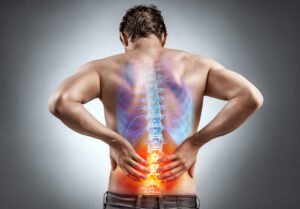
Natural remedies for sciatica
5 Natural Remedies for Sciatica Pain
Chiropractor
Patients who suffer from sciatic nerve pain often find relief from chiropractic adjustments. Adjustments can improve spinal function and in turn, reduce pain.
Yoga
While sometimes moving can aggravate sciatic pain, certain types of movements and stretching can actually reduce pain. Stretches that lengthen the spine or yoga positions that help develop good posture help reduce stiffness, inflammation, and pain.
Yoga is safe and effective for people with sciatic pain. It can strengthen core muscles, relax stiff areas, and help prevent further pain.
Acupuncture
Acupuncture is a traditional Chinese practice that maintains health by releasing the body’s natural energy. Tiny needles are injected into specific, targeted areas. Acupuncture helps improve blood flow, oxygen, and channels energy in a holistic approach. It has been FDA approved to treat back pain and chronic pain of all kinds, including sciatica.
Active Lifestyle
Working at a desk or lounging too long can worsen back pain. Sciatica treatments frequently recommend movement and staying active. An active lifestyle and targeted exercises allow for joints and affected areas to loosen up and relieve pain. Isometric exercises help relieve pain during the day; many of these can be performed at work or on the go. If you typically lead a somewhat sedentary lifestyle, investing in a fitness tracker can help motivate you to set activity goals.
Heating Pads
Heat loosens tight muscles and promotes blood circulation. Many people with sciatica find pain relief by using heating pads on a low setting for 15-20 minutes daily. Applying heat to the affected or painful area can be performed a few times a day, every few hours. Many heating pads are small and travel well, so it can be helpful to use while sitting at work. Another method of heat is taking warm baths. Water relieves pressure from your joints, also reducing pain, while the heat loosens up the muscles. For use on-the-go, one-time-use heating wraps may be used that are effective for several hours.
If you suffer from sciatica pain, the team at Progressive Pain Management can help. Fill out the form below to get in touch.
Arthritis is the swelling and tenderness of the joints. It is a term used to describe over 200 types of joint conditions. Two of the main symptoms that are associated with arthritis are pain and stiffness.
Arthritis Pain
Arthritis pain can be debilitating. In fact, the CDC reports that over one-third of adults who suffer from arthritis are limited in their activities and work.
A few of the most common types of arthritis are osteoarthritis, psoriatic arthritis, and fibromyalgia. All three of these conditions cause different kinds of pain.
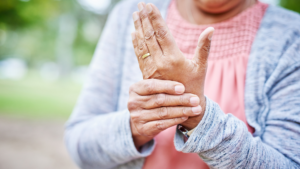
Pain and Stiffness Due to Arthritis
Osteoarthritis
Osteoarthritis causes the cartilage inside the joints to disintegrate. Cartilage acts as a cushion for your bones, so when this break down occurs, the bones of your joints may rub directly against one another. This causes severe pain. However, the pain caused by osteoarthritis varies from patient to patient, depending on location and severity.
Psoriatic Arthritis (PsA)
Psoriatic arthritis is an autoimmune disease. It causes the immune system to attack the body, resulting in inflammation and pain. Psoriatic arthritis can cause a variety of pain to different areas of the body. PsA affects the joints, which causes arthritis. Arthritis affects the soft tissue, tendons, and ligaments that attach to bones causing enthesitis. It can also affect the skin, which causes psoriasis.
Fibromyalgia
Fibromyalgia is a central pain syndrome. Central pain syndrome means your body and brain are affected by pain differently from others. A normal movement for others may cause you severe pain, or something that is painful for others may be excruciating for you. This pain can be widespread – meaning your whole body is affected. But fibromyalgia pain can come and go or be constant. It all depends on the patient.
Stiffness Caused by Arthritis
Joint stiffness is common in patients suffering from arthritis. This is because the stiffness is caused by inflammation. The inflamed area of a joint is typically worsened after periods of inactivity – especially prolonged sitting or standing. Stiffness is particularly common in the morning after a good night’s rest. However, the type of stiffness can be determined by the type of arthritis the patient has.
Rheumatic arthritis causes stiffness after a period of rest. This can occur after sitting for a long period of time, such as at a desk job or sitting in a movie theater. Standing up and walking slowly helps diffuse the stiffness.
Inflammatory arthritis causes a different kind of stiffness. This is temporary stiffness that lasts for a short amount of time. This is most common in arthritis patients in the morning, with the stiffness wearing off after approximately 30 minutes.
Get Relief from Your Pain and Stiffness
The length of time you feel joint pain and stiffness can help your physician determine the type of arthritis you have. Medication is not usually recommended, but the pain and stiffness can be reduced through the use of alternating hot and cold compresses, physical therapy, and exercise to increase your range of motion.
If you are living with arthritis and in daily pain, the team at Progressive Pain Management can help. Contact us today by filling out the form below.
Peripheral neuropathy is the term used for disorders caused by damage to the body’s peripheral nervous system.
The peripheral nervous system connects nerves from the brain and spinal cord to the rest of the body. Including, but not limited to, the arms, legs and feet, joints, eyes, nose, and even the skin. Peripheral neuropathy is when nerves are damaged and cannot send messages from the brain to other body parts. This damage can cause numbness or pain in these affected areas.
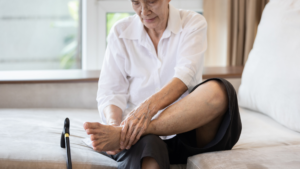
How to Diagnose and Treat Peripheral Neuropathy
Peripheral neuropathy can be separated into two categories: polyneuropathy and mononeuropathy. People most commonly suffer from polyneuropathy.
- Polyneuropathy is when multiple nerves are affected
- Mononeuropathy occurs when only one nerve is affected
How is Peripheral Neuropathy Diagnosed?
There are many symptoms of peripheral neuropathy, such as numbness and tingling, severe sensitivity to touch, lack of coordination, and weakness, to name a few. Because the variety of symptoms is so vast, it can be challenging to diagnose this condition.
A diagnosis program typically includes a review of your medical history, a physical and neurological exam, blood work, and diagnostic testing.
- Medical History. Your doctor will review your medical history and ask questions regarding your symptoms, severity of pain, and what helps relieve the pain. Other factors may include your work environment, anything that triggers the onset of pain, social habits, exposure to toxins, alcohol and tobacco use, and family history of neurological diseases.
- Physical & Neurological Exam. Your doctor will perform a physical exam to look for any diseases that cause nerve damage, such as diabetes or celiac disease. A neurological exam will determine the cause of a neurological disorder and the severity of nerve damage.
- Blood Work. Blood tests are able to test for vitamin deficiencies, organ dysfunction, infections, and any abnormal bodily system activities. These tests can assist the doctor in determining diseases or disorders that cause neuropathic diseases.
Other tests that can be used to test for peripheral neuropathic diseases are imaging tests, nerve and skin biopsies, and nerve function tests.
Types of Treatments Available
Your doctor will recommend a treatment type based on the type of nerve damage, symptoms you display, and the area that is affected. With the guidance of a pain management specialist, you may be able to manage your neuropathic pain and reduce medications. As long as the nerve cell has not died, the consistent and definitive treatment allows for a functional recovery over time.
Treating Underlying Causes
By correcting the underlying cause of your neuropathy, it can many times heal itself and the nerves can recover and regrow. Simple lifestyle changes such as maintaining a healthy weight, eating a nutritious diet, and taking vitamin supplements can improve nerve health. Exercise delivers more blood, oxygen, and nutrients to nerve endings, therefore improving muscle strength and preventing muscular atrophy. Controlling glucose levels has also been shown to reduce neuropathic symptoms and help people with diabetes avoid nerve damage.
If an autoimmune disease or inflammation causes your peripheral neuropathy, symptoms can be controlled by using medications like prednisone. A procedure that involves stripping your blood of immune system cells and antibodies, called plasmapheresis, helps reduce inflammation or subdue immune system activity.
Using Medications
When your peripheral neuropathy is not caused by an underlying disease, medications can be used to minimize symptoms.
- Over-the-Counter Pain Relievers. Medications such as NSAIDs like naproxen, ibuprofen, and aspirin can relieve minor symptoms.
- Topical Treatments. Ointments that contain a substance found in hot peppers has been proven to reduce neuropathic symptoms. Lidocaine patches also provide pain relief, although side effects may include drowsiness, dizziness, or numbness.
- Antidepressants. Antidepressants interfere with the chemical processes in your brain that cause pain. Tricyclic antidepressants like amitriptyline help relieve pain. Drugs like Cymbalta (inhibitor duloxetine) may also ease neuropathic pain. Antidepressants have been known to cause side effects such as nausea, drowsiness, or constipation.
Spinal Cord Stimulation
Spinal cord stimulators (SCS) have been used to treat pain for over 50 years. The implanted device transmits therapeutic electrical signals to provide a therapeutic effect. Neuropathic pain is caused by damaged tissue and nerves. Spinal cord stimulators are surgically placed under the skin. They send mild electrical signals to the spinal cord and nerve fibers. These signals mask pain signals before they can reach the brain.
Therapies to Treat Peripheral Neuropathy
Therapy that helps ease the pain of peripheral neuropathy include:
- Physical Therapy. Muscle weakness and physical disabilities caused by peripheral neuropathic diseases can be reversed under the supervision of a physical therapist and a specialized exercise program. Braces, canes, and walkers may be used to aid treatments.
- TENS. Transcutaneous electrical nerve stimulation delivers a gentle electrical current at various frequencies. Electrodes are placed on the skin over the affected area.
- Plasma exchange. Plasma therapy means your blood is removed, processed to remove antibodies, and returned to your body. This helps suppress the immune system activity that causes inflammation.
Surgery for Peripheral Neuropathy
For some types of neuropathies, surgery is the recommended treatment option. Pinched nerves or conditions that compress nerve roots are generally treated with surgery to free the damaged nerve and allow for proper healing. Mononeuropathy is caused by compression or infections and often requires surgery to release pressure on the nerve.
Polyneuropathies such as diabetic neuropathy is not treated with surgery. If you suffer from polyneuropathy, surgery could potentially make your pain worse. Surgery that involves cutting or injuring the nerve can cause damage to the central nervous system. This has been known to cause phantom pain.
With the evolution of technology, less damaging procedures such as electrical stimulation have replaced surgery to treat peripheral neuropathy. To make an appointment or learn more about peripheral neuropathy, fill out the form below.

